Nocera Superiore
Nocera Superiore (Neapolitan: Nucere) is a city and comune with 24 390 inhabitants in the province of Salerno in the Campania region of south-western Italy.
Nocera Superiore | |
|---|---|
| Comune di Nocera Superiore | |
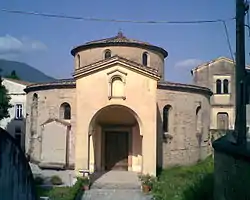 Palaeochristian Baptistery of Santa Maria Maggiore. | |
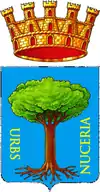 Coat of arms | |
Location of Nocera Superiore 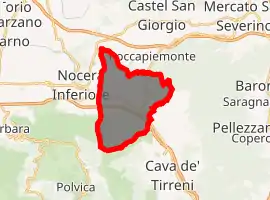
| |
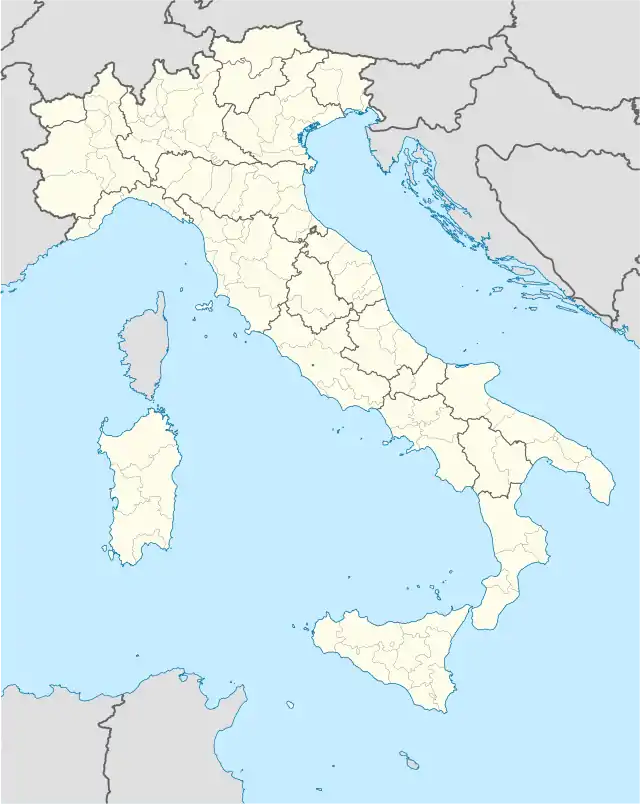 Nocera Superiore Location of Nocera Superiore in Italy 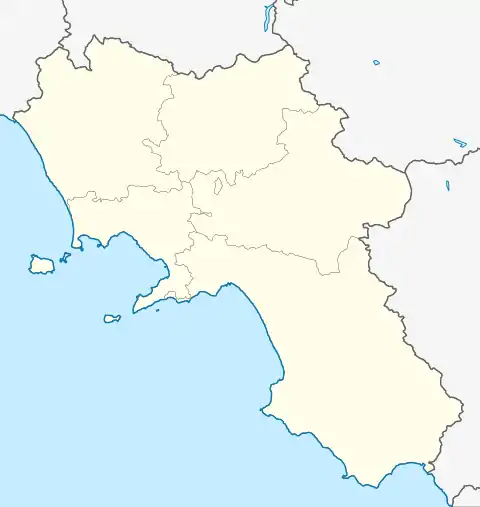 Nocera Superiore Nocera Superiore (Campania) | |
| Coordinates: 40°44′N 14°40′E | |
| Country | Italy |
| Region | Campania |
| Province | Salerno (SA) |
| Frazioni | Croce Malloni, Materdomini, Pecorari, Uscioli, Camerelle, Pizzone, Casa Milite, Citola, Porta Romana, Pareti, Pucciano, San Clemente, San Pietro, Starza, Taverne |
| Government | |
| • Mayor | Giovanni Maria Cuofano |
| Area | |
| • Total | 14.66 km2 (5.66 sq mi) |
| Elevation | 70 m (230 ft) |
| Population (30 November 2017)[2] | |
| • Total | 24,390 |
| • Density | 1,700/km2 (4,300/sq mi) |
| Demonym(s) | Nocerini |
| Time zone | UTC+1 (CET) |
| • Summer (DST) | UTC+2 (CEST) |
| Postal code | 84015 |
| Dialing code | 081 |
| Patron saint | St. Cyrus |
| Saint day | January 31 |
Its history, up until 1851, is in common with the adjacent Nocera Inferiore: the two cities share a common origin.
Geography
The city is located on the northern ridge of Monti Lattari, in Agro Nocerino Sarnese valley.
- Seismic hazard: zone 2 (medium hazard level), Ordinance PCM n. 3274 of 20/03/2003.
History
Servius tells that, around 1500 BC, the Pelasgians, natives to Asia, arrived in Italy through the Alps, however this is just a fanciful story: history says that around VI century BC the Osci, an Italic people of Campania, gave rise to the original settlement of Nuceria, located in Nocera Superiore, between the current Pareti and Pucciano districts. This site was chosen due to its favourable geographic position characterized by water sources and a very fertile hinterland protected from winds.
At its greatest expansion, Nuceria, famous for the robustness of the town walls, enclosed the current districts of Pareti, San Pietro, Pucciano, Grotti, Portaromana, Santa Maria Maggiore and San Clemente. There are astonishing similarities between the fortifications of Nuceria and Pompeii. Nuceria is rectangular with scarps defending the north, west, and east of the city while the southern side had the strongest fortifications as the most vulnerable section and, like Pompeii, featured a tufa opus quadratum double wall with an agger behind.[3]
During the Second Samnite War the town adhered to the Italic cause and in 310 BC Roman troops sacked the territory of Nuceria but at the end of the conflict the city obtained favourable treatment and entered into an alliance with Rome as a civitas foederata.[4]
In 280 BC, Nuceria presided over a confederation that included Sorrento, Pompeii, Stabia, and Ercolano, and minted coins on which the expression Nuvkrinum Al(a) faternum was engraved.
During the Second Punic War (218 – 201 BC), the defences proved formidable enough that Hannibal reduced the city by starvation because of its loyalty to Rome, rather than by direct attack, though subsequently destroyed it in 216 BC.[5] After the war the defences were rebuilt and strengthened with the addition of towers in opus incertum.
Its territory was ravaged during the Social War (90 BC) and by the troops of Spartacus. During the period of the triumvirate the town was named Nuceria Costantia.
The earthquake in 62 AD and the eruption of the Vesuvio in 79 AD caused serious damages to the town which never reached the previous prosperity.
During the VI century the Lombards, under King Alboin, forced Nuceria to surrender: they placed it under the supremacy of the Duchy of Benevento. After the mid-9th century the town was part of the principality of Salerno first, and then of the principality of Capua. Nuceria, located where the future Nocera Inferiore would rise, was besieged by Roger II of Sicily in the battle in 1132, after four months he razed the town to the ground.
After its reconstruction, the birth of the modern Nocera began with many hamlets and villages which gradually expanded and became small towns.
During the Angevin dominion (1266 - 1435) Nocera was rebuilt and took the name of Nuceria Cristianorum, then in the XV century was changed in Nocera dei Pagani. Throughout the Spanish domination Nocera was divided into four municipalities: Nocera Soprana, Nocera Sottana, Barbazzano, Sant'Egidio, each one with its own mayor.
Toward the end of the XVI century Nocera was divided into seven municipalities: Nocera Corpo, including the current Nocera Superiore and Nocera Inferiore districts of Piedimonte, Pietraccetta and Borgo; Nocera San Matteo, including the current Nocera Inferiore districts of Merichi and Liporto; Nocera Tre Casali, including the current Nocera Inferiore districts of Capo Casale, Casale Nuovo and Casale del Pozzo; Barbazzano, Pagani, Sant'Egidio and Corbara.
In 1807 comuni were established. In 1828 the fourteen districts of Nocera Corpo asked for self-administration which was granted by decree n.1960 on 11 november 1850, with effect from January 1, 1851. Thus was born the current Nocera Superiore.
Etymology
A theory, based on Servius' story, is that the ancient inhabitants of Nuceria, the Pelasgians, wanted to recollect their native land: in Macedonia there is the Crio promontory; in Crete there is the Crium promontory; in Lycia there is a place called Cria. So the etymology of the name would therefore result from the adjective Nou, Nu, which means "new", and Crio, Crium, Cria, with Nukria, Nucrium, Nuceria as "New Cria".
Actually, the name Nuvkrinum Alafaternum derives from nuv + krin-um + alafatern-um, word by word New (= nuv) Fortress (= krin) of the Alfaterni, an Italic people of the Agro Nocerino Sarnese.
Coat of arms

The city's emblem is the same of the old Nocera dei Pagani. It has been recognised by decree of the President of the Republic on 6 April 1987 and has the following description:
«d'azzurro, al noce sradicato, di verde, fruttato d'oro, accompagnato ai fianchi delle parole "Urbs Nuceria" in lettere maiuscole romane d'oro, poste verticalmente, la parola Urbs in bordatura nel fianco destro e con la U iniziale all'insù, la parola Nuceria in bordatura nel fianco sinistro e con la A finale all'insù. Ornamenti esteriori di città.» |
«light blue, uprooted walnut, green, fruity golden, accompanied on the sides by the words "Urbs Nuceria" in golden Roman capital letters, placed vertically, the word Urbs in the border on the right side and with the initial U upwards, the word Nuceria in the border on the left side and with the final A upwards. Exterior city ornaments.» |
The town's standard is described as follows:
«drappo partito di giallo e di verde riccamente ornato di ricami d'oro e caricato dello stemma comunale con la iscrizione centrata in oro: "Città di Nocera Superiore". Le parti di metallo e i cordoni sono dorati. L'asta verticale è ricoperta di velluto dei colori del drappo, alternati, con bullette dorate poste a spirale. Nella freccia è rappresentato lo stemma della città e sul gambo inciso il nome. Cravatta con nastri tricolorati dai colori nazionali frangiati d'oro» |
«yellow and green standard lavishly adorned with gold embroidery, having the municipal emblem with the gold-centered inscription: "Città di Nocera Superiore". The metal parts and the ropes are golden. The vertical shaft is covered in velvet with the colors of the drape, alternating, with golden tacks placed in a spiral. The emblem of the city is represented on the arrow and the name is engraved on the stem. Tie with tricolour ribbons in national colours golden fringed» |
Main sights
- Parrish Church of St. Bartholomew the Apostle in Pareti
- Paleochristian Baptistery of Santa Maria Maggiore. It is a 6th-century circular structure, based on Byzantine style with a double row of 15 columns topped by arches on which rests a dome.
- Materdomini Basilica Shrine
- Parrish Church of Mary Most Holy of Costantinopoli in Pecorari
- Church and Convent of Saint Mary of the Angels
- Hellenistic theatre in Pareti
- Medieval street in Uscioli
- Monumental Necropolis in the archeological site of Pizzone
Culture
Traditions and folklore
- Solemn celebrations in honour of the city's Patron, St. Ciro (31 January, Pareti)
- 'A Trasuta 'e San Ciro Festival and Salata di San Ciro National Contest (June, Pareti)
- International Contest of Madonnari, St. Paschal Baylon and Mary Most Holy of Costantinopoli's Festival (May, Pecorari): street artists from all over the world called madonnari make religious drawings on the ground of the streets by using just chalks.
- St. Mary's Festival (also called Festa dell'Assunta, 14 and 15 August, Materdomini). During the summer of 1401 a peasant, hereinafter called Caramari (which means dear to Mary), had a vision: the Virgin Mary suggested that she dig under the oak where she was sleeping in order to find one of her icons. That was how a gorgeous painted wooden board of the Blessed Virgin Mary, in Byzantine style, came to light. During the night between 14 and 15 August many devotees go to the Shrine of Materdomini in order to obtain full indulgence. In the square in front of the Shrine popular dances are accompanied by tammorre (tambourine), scetavajasse (a sort of tambourine played with a rod equipped with disks made of tin), and triccheballacche (a musical instrument consisting of three wooden hammers, one central unmovable hammer and two movable side hammers, equipped on the outside with disks made of tin). During this festival citizens eat the palatella câ 'mbupota 'e alice, a type of bread filled with aubergines marinated in vinegar and anchovies.
- Way of the Cross' sacred representation (Good Friday, Pizzone's excavations and Pecorari)
- Way of the Cross in Casa Milite's mountain village (Friday before Palm Sunday)
- Procession of the Mysteries (Good Friday, Pucciano, Pareti and S.Clemente's streets)
- Living nativity scene (Christmas period, Uscioli)
- Christmas Village and Christmas Market (13 and 14 December, Pecorari)
- St. Anthony of Padua's Festival (June, Camerelle)
- Majo's Festival (May Day, Materdomini), documented from 1758: during a procession Nocera Superiore and Roccapiemonte's mayors along with the Confraternity of the Most Holy Rosary's prior bring the majo (three adorned little trees) to the Madonna of Materdomini in order to propitiate good crops.
Languages and dialects
Nocera's dialect, called nocerese, corresponds to the Neapolitan language with small variations: the "e" vowel is always pronounced as an open one and sometimes there is a tendency to replace the gerund's suffix -anne with -enne: stann' aspettenne, stann' magnenne ("they're waiting", "they're eating").
Libraries
- Municipal Library of S.Clemente
- Library of Parish of Mary Most Holy of Costantinopoli (Pecorari)
- Library of the Convent of Saint Mary of the Angels (Grotti)
Trivia
- In October 1964 the King Gustaf VI Adolf of Sweden, great archeology enthusiast, along with his wife Louise Mountbatten visited Nocera Superiore's Baptistery accompanied by the parish priest of Santa Maria Maggiore.
- The Danish author Hans Christian Andersen visited the Baptistery during the year 1834.
See also
References
- "Superficie di Comuni Province e Regioni italiane al 9 ottobre 2011". Istat. Retrieved 16 March 2019.
- All demographics and other statistics: Italian statistical institute Istat.
- The City Walls of Pompeii: Perceptions and Expressions of a Monumental Boundary by Ivo van der Graaff, M.A. Dissertation. Graduate School of The University of Texas, p. 158
- Livy 9.38
- Johannowsky, W. "Considerazioni sull’architettura militare del II Sec. a.C. nei centri della lega nucerina." In Nuceria Alfaterna e il suo territorio: Dalla fondazione ai Longobardi, 123–135. Nocera Inferiore, 1994. p 123.